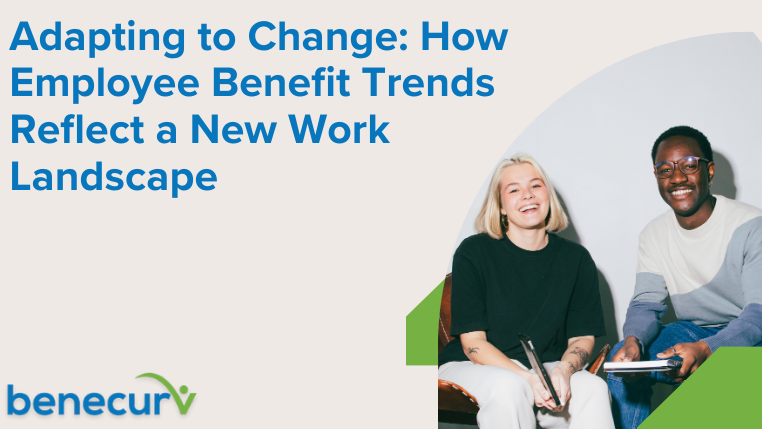Adapting to Change: How Employee Benefit Trends Reflect a New Work Landscape
Adapting Employee Benefits: Navigating the New Work Landscape

The world of work is undergoing a seismic shift. Remote work models are becoming normalized, the gig economy is rapidly expanding, and employee expectations regarding work-life balance and well-being are evolving at an unprecedented pace. In this dynamic environment, traditional employee benefit packages are no longer enough. Companies need to adapt and offer benefits that reflect the realities of the new work landscape. This guide explores the evolving trends in employee benefits and how they mirror the changing nature of work.
Employee Benefit Trends: The Rise of a New Work Reality
Several factors contribute to the emergence of a new work landscape:
- Technological Advancements: Cloud-based technologies and collaboration tools have facilitated remote work opportunities, making geographic location less relevant for many roles.
- The Gig Economy: The gig economy allows individuals to work on a project or freelance basis, offering flexibility and independence, but often lacking traditional employee benefits.
- Shifting Workforce Demographics: Millennials and Gen Z constitute a significant portion of the workforce. These generations prioritize meaningful work, work-life balance, and financial security.
- The Great Resignation: Many employees are reevaluating their careers and priorities, leading to a surge in job changes and a tight labor market. Companies need to compete for talent with compelling benefits packages.
Employee Benefit Trends in the New Work Landscape
To attract and retain top talent in this evolving environment, companies need to rethink their approach to employee benefits. Here are some of the most prominent trends that reflect the changing nature of work:
- Flexibility Reigns Supreme:
Employees today crave control over their schedules. Benefits that offer flexibility are no longer a perk, but a necessity. This includes options like remote work, flexible hours, compressed workweeks, and hybrid models that combine on-site and remote work. Flexibility empowers employees and can lead to increased productivity and satisfaction.
- Focus on Well-being:
Employee well-being has become a top priority. Companies are offering benefits that go beyond traditional health insurance. This may include mental health resources, financial wellness programs, stress management workshops, and access to telehealth services. Investing in employee well-being promotes a healthier, happier, and more productive workforce.
- The Rise of Personalized Benefits:
A one-size-fits-all benefits approach no longer meets the diverse needs of today’s workforce. Companies are increasingly offering customizable benefit packages that cater to individual preferences. This may include allowing employees to choose from different health insurance plans, supplemental insurance options, or wellness programs.
- Benefits for the Gig Workforce:
The gig economy is here to stay. Companies are exploring benefits that can be extended to contract workers or freelancers. This may include access to health insurance plans, paid time off options, or professional development opportunities.
- Student Loan Assistance:
Student loan debt is a major burden for many young professionals. Employers are increasingly offering student loan repayment programs or assistance programs to help alleviate this financial stress. This benefit can be a significant differentiator in attracting younger talent.
- Financial Wellness Programs:
Financial stress can negatively impact employee well-being and productivity. Companies are offering financial wellness programs that equip employees with the tools and resources to manage their finances effectively. This may include financial education workshops, budgeting tools, and retirement planning resources. Employee benefit trends
- Support for Working Families:
Finding a balance between work and family life can be challenging. Companies are offering benefits that support working families. This may include generous parental leave policies, on-site or subsidized childcare options, or back-up childcare resources.
- Focus on Diversity, Equity, and Inclusion (DE&I) Benefits:
DE&I practices go beyond hiring diverse talent. Companies are offering benefits that promote an inclusive workplace culture. This may include unconscious bias training, employee resource groups for diverse populations, or culturally sensitive healthcare plans. A welcoming and equitable work environment fosters increased employee engagement and retention.
- Blending Work and Life: Perks That Matter
Benefits are no longer solely focused on healthcare and finances. Companies are recognizing the importance of perks that enhance work-life balance and employee satisfaction. This may include gym memberships, fitness trackers, discounts on healthy food options, or pet insurance. Offering these perks demonstrates a commitment to employee well-being beyond traditional work hours.
- Focus on Learning and Development
Continuous learning and development opportunities are highly valued by employees today. Companies can offer tuition reimbursement programs, professional development workshops, and access to online learning platforms. Investing in employee development not only benefits the employee but also strengthens the company’s talent pool and fosters a culture of innovation.
Beyond Benefits: Building a Flexible and Engaging Workplace
While competitive benefits are crucial, creating a truly adaptable work environment requires more than just the benefits package. Here are some additional considerations:
- Strong Employer Branding: Develop a strong employer brand that communicates your company’s commitment to flexibility, well-being, and continuous learning. Utilize social media and career pages to showcase your company as an employer that embraces the new work landscape.
- Building a Remote-Friendly Culture: If offering remote work options, invest in the necessary tools and technologies to facilitate effective communication and collaboration among geographically dispersed teams. Additionally, establish clear expectations and policies for remote work to ensure productivity and maintain a positive work environment for all employees.
- Prioritizing Employee Well-being: Implement initiatives that promote physical and mental health. Offer flexible work arrangements to reduce stress and burnout. Provide access to mental health resources and encourage open communication about mental health concerns.
- Creating a Culture of Learning: Foster a culture that encourages continuous learning and development. Offer opportunities for employees to learn new skills and broaden their knowledge base.
- Building a Strong Employer-Employee Relationship: Open communication, transparency, and valuing employee feedback are essential for building a strong employer-employee relationship. Regularly gather employee feedback on their needs and priorities to ensure your benefits package remains relevant and effective.
Conclusion: Thriving in the New Work Landscape
The new work landscape presents both challenges and opportunities for companies. By embracing the latest trends in employee benefits, promoting flexibility, prioritizing well-being, and fostering a positive work environment, companies can attract and retain top talent, drive employee engagement, and thrive in this evolving world of work. Remember, a flexible and adaptive approach to employee benefits, combined with a commitment to employee well-being and development, will ultimately contribute to a successful and resilient organization.
FAQs About Adapting Employee Benefits to the New Work Landscape
How can I convince my company to offer a specific benefit?
- Conduct research on the emerging trends discussed in this blog and identify benefits that align with your company culture and workforce needs.
- Present a well-researched proposal to your HR department or management, highlighting the potential benefits for both employees and the company (e.g., increased employee satisfaction, reduced turnover).
- Gather support from colleagues who may also benefit from the proposed benefit.
What are the challenges of offering a remote work environment?
- Maintaining effective communication and collaboration among geographically dispersed teams.
- Establishing clear expectations and boundaries for remote work.
- Ensuring a positive and inclusive work environment for all employees, regardless of location.
How can I stay informed about the latest employee benefit trends?
- Subscribe to industry publications and blogs focused on human resources and employee benefits.
- Attend industry conferences and webinars on HR trends.
- Network with HR professionals in your field.
By keeping abreast of the latest trends and best practices in employee benefits, companies can ensure they are offering a competitive and relevant package that attracts and retains top talent in the dynamic new work landscape.



